By: Travis Allen
Khans of Tarkir, or perhaps more appropriately “Fetchlands of Tarkir,” is bearing down on us quickly. There will be no shortage of things to talk about once we get there, but before we do I want to take a quick look back at Journey Into Nyx. I’ve started publicly reviewing my reviews as an additional level of accountability, and as a learning exercise both for my readers and I. Seeing the calls I made and why I made them can help both you and I be better at it in the future. It also provides a scoreboard for everyone keeping track at home for how well I’m doing. It’s very easy to say “oh X card will be worth $20” or “z is trash and will be bulk,” then forget all about those predictions when they don’t come true. I don’t mind tooting my own horn when I made a public statement and it comes true later, but I’m also willing to own up when I made a bad call, as I did last week in reference to the return on the fetchlands.
A quick note on those: since the article went up there’s been a lot more discussion on the topic. While I steadfastly believe they aren’t in Fate Reforged, I’m warming up to them being in Louie. I still am not wholly convinced, and Chas Andres also agrees that they are unlikely there, but I’d be the worst kind of person if I refused to learn from my mistakes and the insight of others.
That said, let’s see how I did with my review of Journey Into Nyx. Italics will be text from the original review.
White
Bulk:
Dawnbringer Charioteers
Dictate of Heliod
Launch the Fleet
Skybind
All right where I want them to be. Launch the Fleet is hanging on at the upper end of bulk as there are whispers it may be good enough. Perhaps in two months it will be. It’s right where anticipated for rotation though.
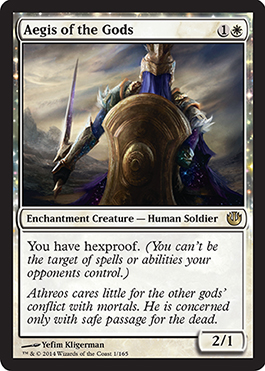
Aegis of the Gods
Rotation: Bulk
Currently $1 on MTGPrice, I was spot on here. It’s seen close to no play at in any format.
Deicide
Rotation: Bulk – $1
$1.96 on MTGPrice, and about $1-$1.50 on TCGP. Admittedly better than bulk, but not by much.
Godsend
Rotation: $2-$3
$5.63 on MTGPrice right now, with a few copies available at $3.50 on TCGPlayer. I had the right idea about where this was going to land, although it’s a few bucks more than I thought it may be. My expectations of its competitive chops were accurate, so I think what we’re seeing here is the limited supply of Journey pushing the price a little higher than the card would normally have. Same thing for Deicide, and many other cards I’ll be looking at today.
Blue
Bulk:
Daring Thief
Hypnotic Siren
Polymorphous Rush
Scourge of Fleets
Battlefield Thaumaturge
Rotation:???
I don’t think Thaumaturge will take off right away. There isn’t anywhere he belongs yet so it will take time for him to find a deck. Delver took some time before he had a proper home, after all. We may even have to wait for rotation and the subsequent cardpool/metagame to undergo a major shift. He’ll require the right enablers for sure. If we get the right mix of spells he’ll be a format role-player, but if we don’t get the tools he’ll be filling boxes of shame nationwide. His best chance today is probably going to be with Young Pyromancer.
I mostly talked about how good the card seems like it could be, and I still stand by that assessment. More problematically is that since this review Thaumaturge was printed in an event deck. After what happened with Advent of the Wurm, I’m staying away from anything in those decks. Thaumaturge may eventually end up a few bucks but I’m not going to own any when it does.
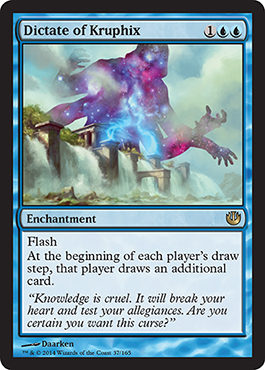
Dictate of Kruphix
Rotation: Bulk – $1
Bingo.
Sage of Hours
Rotation: $2-$3
$1.96 on MTGPrice. Overall he’s a tad cheaper than I expected, but this is a slow grower anyways. I’m still a big fan of this long term, and with the recently spoiled Hardened Scales this could potentially be a fringe player in Standard. Not good, mind you, since Wizards doesn’t want combo anywhere near Standard, but a fringe player nonetheless.
Black
Bulk:
Dictate of Erebos
Doomwake Giant
Extinguish All Hope
King Macar, the Gold-Cursed
Silence the Believers
Worst Fears
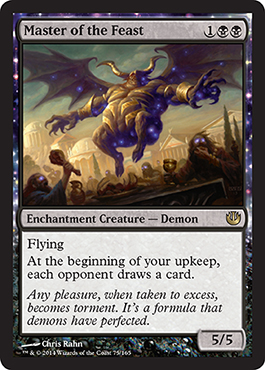
Master of the Feast
Rotation: Bulk? $10?
Master of the Feast is going to be an all or nothing card. Either the drawback is going to be too much and he’s going to end up at total bulk, or he’s going to pull a Desecration Demon and climb to $10+. Either way, I think he’s hitting $1 before he gets his chance to shine so you’ll have some time to make a decision either way.
This has proven reasonably accurate so far. He’s dropped to $3.50 on MTGPrice and I haven’t seen him in a single competitive list yet. There’s clearly a bit of lingering demand, as he hasn’t quite fallen all the way into the bulk bin yet. He’s been steadily dropping since release, so my prediction that he reaches $1 before possibly spiking is still viable. At this point in time I’d say it seems more likely he ends up at under $2 rather than tears up Standard.
Red
Bulk:
Bearer of the Heavens
Dictate of the Twin Gods
Harness by Force
Spawn of Thraxes
Twinflame
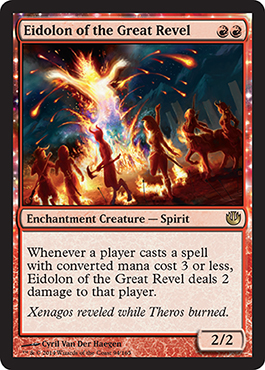
Eidolon of the Great Revel
Rotation: Bulk – $1
This is my biggest miss by a wide margin, so let’s see what went wrong. Here’s what I had to say about it.
Probably more important for Legacy and Modern than Standard…The Legacy and Modern implications will be different. Both formats are packed with small spells so he’ll have much more relative strength. He’ll die more often for sure, but at least anything that’s killing him is probably going to shock it’s controller….The biggest issue financially is that there’s going to be exactly one deck in each format that wants to cast him. This isn’t like Courser of Kruphix that can go in any deck that makes green mana. Eidolon only goes in the most aggressive of red lists, which means the overall demand for him will remain lowish. I see him slipping towards bulk prices, but I don’t think he’ll get too far below $1 or so. I don’t believe that he’s a Vexing Devil or Goblin Guide, but he’s still better than Firedrinker Satyr. If he has a very slow descent or even seems surprisingly resilient after the honeymoon period is over, that probably means the casual market likes him, which will make him safe as a long-term pickup regardless of his tournament success.
I was mostly correct in my power level read, perhaps being a tad conservative. I was also right that it would be a bigger deal in Modern and Legacy than Standard. Where I erred appears to be in my appreciation for how much a card of this caliber can cost. It turns out that being one of the best burn spells in eternal formats, even if it is only playable in exactly the burn deck, is enough to make the card worth over $7. There’s also some amount of casual burn demand that I overlooked. Plenty of individuals out there that enjoy playing Lava Spike at their kitchen table, I’m sure much to the chagrin of their peer group. I did have the foresight to give myself an out; I commented that if his price didn’t decline as quickly as you would think that there would be more than the originally anticipated demand. I still feel far short of where I needed to be though.
The lesson here is that single-deck staples are still capable of reaching respectable prices, even for decks I personally don’t care much for. I had the right idea with Revel, but didn’t respect how much a card of that type can be worth. In the future I need to recognize that multi-format staples, even if they’re only a staple in a single deck, will probably fetch at least several dollars.
Prophetic Flamespeaker
Rotation: $8+
Flamespeaker is $5.64 on MTGPrice right now, so while I was a little aggressive, I’m still in the right neighborhood.
Being a mythic from a small spring set as this, it won’t take much to get his price up. I think he’s going to come down from his roughly $10 preorder price in the near future, but will climb above $10 again when people start realizing how much power he puts on the table.
Flamespeaker has seen some occasional play in Modern Jund, as well as a handful of Standard builds floating around. There isn’t much doubt to his power level, rather, it’s a question of whether anyone can utilize it. The fact that he isn’t $2 or $3 means I didn’t completely miss and that people are on board, just not enough yet. I think I was afraid of missing the next big thing here, so I set the price a little higher in the hopes that it wouldn’t look like I way undervalued him if he was $15 today.
Overall I don’t feel too bad about this. I think it’s entirely possible he does climb above $10 in the next two months, and even if he didn’t, I was only slightly too eager.
Green
Bulk:
Dictate of Karametra
Hero’s Bane
Hydra Broodmaster
Pheres-Band Warchief
Setessan Tactics
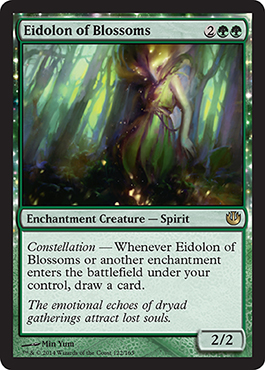
Eidolon of Blossoms
Rotation: $3-$7
I expect Eidolon of Blossoms to very slowly dwindle towards $2-3 but it may be sticky due to people wanting to try it out and likely needing three to four copies. I don’t think it will really get a whole lot lower than that as some people will always be interested. Beyond that, if it does turn out to be solid it will behave like Courser of Kruphix and Sylvan Caryatid. I wouldn’t get rid of these at the Prerelease, and if it’s the type of card you see yourself playing, don’t feel bad about trading for a playset. The worst that happens is that you trade for them at $2-$3 and they end up at $1.
While my expectation of Blossoms’ price was a little high, overall I was spot on. My description of the power level was fairly accurate. It dwindled in value after release, and after a solid performance at the Pro Tour it jumped north of $4. Only in the last few weeks has it dwindled back beneath the $3 mark. What’s keeping Blossoms from being $10 is that it hasn’t seen much success since the Pro Tour. The complete lack of support in M15 but rather the printing of Back to Nature didn’t help, that’s for sure. Khans looks like it may provide some assistance though, as Courser is poised to be one of the best cards in the format and the Ascendancy cycle is looking like it may be playable at this point. In general I may have been a little on the eager side of things when it came to Blossoms, but I’m pleased with the call.
Gold
Bulk:
Revel of the Fallen God
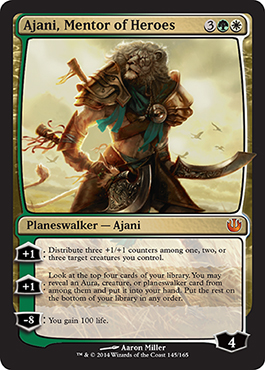
Ajani, Mentor of Heroes
Rotation: $9-$13
I fell short here, but not by an embarrassing amount.
The one thing Ajani has going for him will be his relative scarcity. That may push his price a bit higher than we would normally see for a fringe Planeswalker. If he does about as well as I expect, he should mostly be in the low teens and even under ten. If he sticks around $15, it will be because of the spring set bump.
With a current price of $16.50, it’s clear Ajani outperformed my expectations by ten or twenty percent. He’s been mildly playable so far in Standard, but on the other hand I didn’t see any copies at the recent SCG invitational in New Jersey either. I also made sure in the original review to recognize the possibility of his price sticking a little higher with attribution to the set size.
I feel like my read on his power level was quite accurate given how much tournament play he’s seen, which leads me to believe that the reason his price is higher than I anticipated is because of set economics. That’s not a bad place to be.
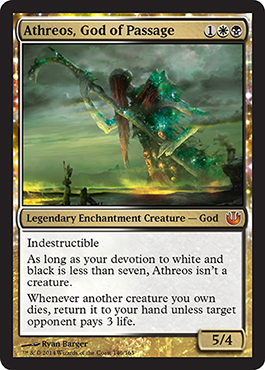
Athreos, God of Passage
Rotation: $14-$18+?
Hoo boy, now that is a God. He’s aggressively costed, revives a previously-successful Standard archetype, and will be popular in EDH. Those are all markers of a hefty price tag. The only reason I’m not expecting $40+ is because there is a little too much else going on in this set for him to turn into a Voice of Resurgence.
People think Athreos is good, and for good reason. Because of that his price will be slow to fall. If he sees very little Standard play, I don’t think he can get much below $10-$13. If he’s part of a major Standard deck, expect him to stick closer to $20, or perhaps even more depending on how pronounced the small set effect is.
This wasn’t as bad as Eidolon of the Revel, but it was close. Athreos was possibly the most-hyped card coming into the set. Many saw him as a legitimate engine, capable of putting a lot of pressure on the opponent either through creature recursion or life payments. While it isn’t the type of card I like to play, I respected the excitement of those around me and judged his price accordingly.
To be fair, it took over a month before he dropped below $15 on MTGPrice so clearly there was continuing demand. He just couldn’t cut it though, and subsequently his price dropped to match his tournament results. His golden age has probably passed, so at $8 I’d probably ship him now.
I messed up Revel pretty good but I’m not beating myself up over Athreos. Many people, including pros, really thought Athreos was going to be a big player. I listened to those around me and made a call based on that. If he was as good as people thought he may have been, my numbers would have been where they needed to be. Ultimately this is a miss, but one in which I think I made the right play and got a bad result.
Iroas, God of Victory
Rotation: $6-$9
People will play him, and there will be some casual appeal, but it won’t be enough to keep him inflated with several other spicy mythics and rares in the set. The small set effect should keep him above Nylea and Heliod, but not by too much.
Currently at $5.38 on MTGPrice, I like where I landed on this guy. I said he should be more expensive than Nylea and Heliod. Nylea is seeing a bit of a renaissance right now and has climbed a bit above Iroas, but Heliod remains low.

Keranos, God of Storms
Rotation: $6-$9
On the one hand, Keranos has the best or second best text box of all the gods this time around. He is always doing something that matters, whether it’s putting cards into your hand or draining your opponent’s board/life total. On the other hand he’s a little expensive and it will take some time for his ability to really take a game over. I think he’s nearly as playable as Athreos is, but unlike Athreos will likely not be a four-of wherever he ends up. We also don’t have a home for him to slot into right away which makes it tougher for him to maintain his current $10-$15. The best advice I can give on Keranos is to expect nothing in the short term, but pay close attention to the block Pro Tour.
Keranos is $16 right now but I’m totally calling this a win. Why? From June 1st to September 1st, he was in the $6-$9 range. It was only a week or so ago that his price rose so dramatically. I am also under the impression that his spike was due in part to a buyout, which can change prices prematurely. (Not unfounded changes mind you, just premature.) Once we started to see him pop up in Modern occasionally or two after release I was warming up to him, and was recommending him as a pickup by the time we hit August. I had an accurate read at release, and I was able to update my opinion on him over the summer as it became clear he was a threat in more than one format.
Kruphix, God of Horizons
Rotation: $3-$5
Currently $3.43. The price is dead on and my review of “Ugh.” says everything else.
Pharika, God of Affliction
Rotation: $4-$6
Pharika is preselling on Channelfireball right now for a whopping $7 so there obviously there isn’t a whole lot of hype surrounding her at this point. Most people are relatively unimpressed, but I’ve heard from a few intelligent people that there’s some silver lining here. She’s cheap with a nice fat body. She’s in green, so we can see her come down on turn two, potentially allowing you to put four colored mana symbols into play on turn three and swing for five. She recycles your dead bodies into threats, which is great in attrition decks, a common theme for GB. Perhaps most importantly and mostly under the radar, those snakes she puts into play are enchantments. That means they trigger constellation, such as on Eidolon of Blossoms or Underworld Coinsmith or Doomwake Giant.
Will any of that be enough to keep her above bulk god prices? Honestly, probably not. She’s going to slip before she rises again, and if she ever does make it back above $10 I don’t think it will be overnight. You’ll have time to react if she sees an uptick in play and price.
Pharika is $4 at the moment so my price prediction was quite good. She’s done about as much as I thought she would up until now, which is to say basically nothing.
I’ll use this space to say that Pharika is growing on me. As I said earlier, Courser is shaping up to be one of the defining cards of the new meta. Pharika really likes Courser, as he adds double devotion. She also likes cards such as Eidolon of Blossoms, which also likes Courser. How about that! Pharika is even in Sultai, which is giving us delve and the cards to support it. With wedge cards floating around it may not be too tough to turn Pharika on. I’d keep my eye on her going forward.
Hall of Triumph
Rotation: $1-$3
Mono-Blue could possibly be in the market for two of these, and decks running Prophetic Flamespeaker could conceivably be interested as well. I believe this will always manage to stay a little above bulk, and will probably climb towards $5 in the months and years after rotation.
At $.74, I’d say I was in the right ballpark. Mono-Blue did in fact start running these, with a few having shown up in the Top 8 of some SCG Opens. That deck has been on the downswing for awhile though, as all the other decks keep getting better and better while it gets nothing. The deck slowing down has prevented Hall of Triumph from getting anywhere. I maintain that the card’s outlook is good two or three years down the line, but that’s a long time to wait to make a dollar or two per card.
Lands
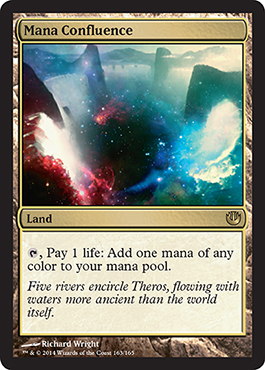
Mana Confluence
Rotation: $9-$12
I’d say we’ll see this in the $10-$12 range for the most part, but it may take some time to get there. If it ends up over-performing we’re probably looking at it being $15+. If Thoughtseize can’t break $20, I don’t think MC can.
As of September 3rd, Mana Confluence was just under $11 – right at my predicted target. The next day it jumped to over $16, where it remains today. This, like Keranos, was doing exactly what I expected it to right up until just a few days ago. In Confluence’s case, the spike was a result of PAX. Once the Khans spoilers began trickling in people jumped on Confluence. I figured a jump was coming but I didn’t think we would see it until after rotation. I guess people are getting a little wiser about when they need to grab their staples.
I previously said I didn’t think MC could break $20, but I’m revising that now. While I don’t think it’s an auto-4-of in every wedge deck, I do think it will be an important component of the metagame. The presence of fetchlands should also actually help MC. Fetchlands are “dual” lands right up until you crack them, at which point they no longer offer both colors of mana. For decks trying to hit CDE consistently, fetches may fall short. The Temples and MC will have to do some work to fill in the gaps.
The Temples
Rotation: $7-$8+
Most of the other Temples are in the $5-$6 range and there will be considerably more of those than there are of these. Lands nearly always rise at rotation and there’s no reason to expect ones with such a strong effect to behave any differently. Don’t hesitate to trade or buy your set now. You pretty much can’t lose. Hoard any you can get in trade because it’s likely enough that they break $10 that it’s totally worth risking them being $4-$5.
Temple of Epiphany is $7 and Malady is $11 right now. Epiphany is spot on; Malady ended up climbing more than I originally anticipated because of how good the BG combination became in Standard. (It’s currently the most expensive scryland.)
Unless the missing cycle of lands in Khans ends up being a big deal for constructed, I really like the scrylands as a component of Standard manabases with fetches in the format. As I mentioned above, fetches can’t continually make two colors. This is going to put a lot more pressure on Standard decks to keep the scrylands around in order to consistently hit their costs.
At the end of the day I’m reasonably pleased with how my prediction of the set went. I did a great job identifying the bulk cards. Two cards that jumped well past my prediction only did so in the last week or two, before that having followed my timeline closely. They’re also two cards that I later on earmarked as good pickups on Twitter and/or in real life, so I was onto them after the review went live.
The biggest miss here was Eidolon of the Great Revel, where I was off by a decimal place. I failed to appreciate just how much demand the older formats and casual circles would place on such a narrow card. I’ll need to be more careful about respecting just how much demand a card such as this can generate. Beyond that a handful of my predictions were off, but only by a handful of dollars at worst. You can’t really expect to get every single card exactly right, so those gaps between my guesses and the true prices are mostly within the accepted margins of error. I’d say I deserve a B+ or an A- on this review, with Revel being my only big strike.

















